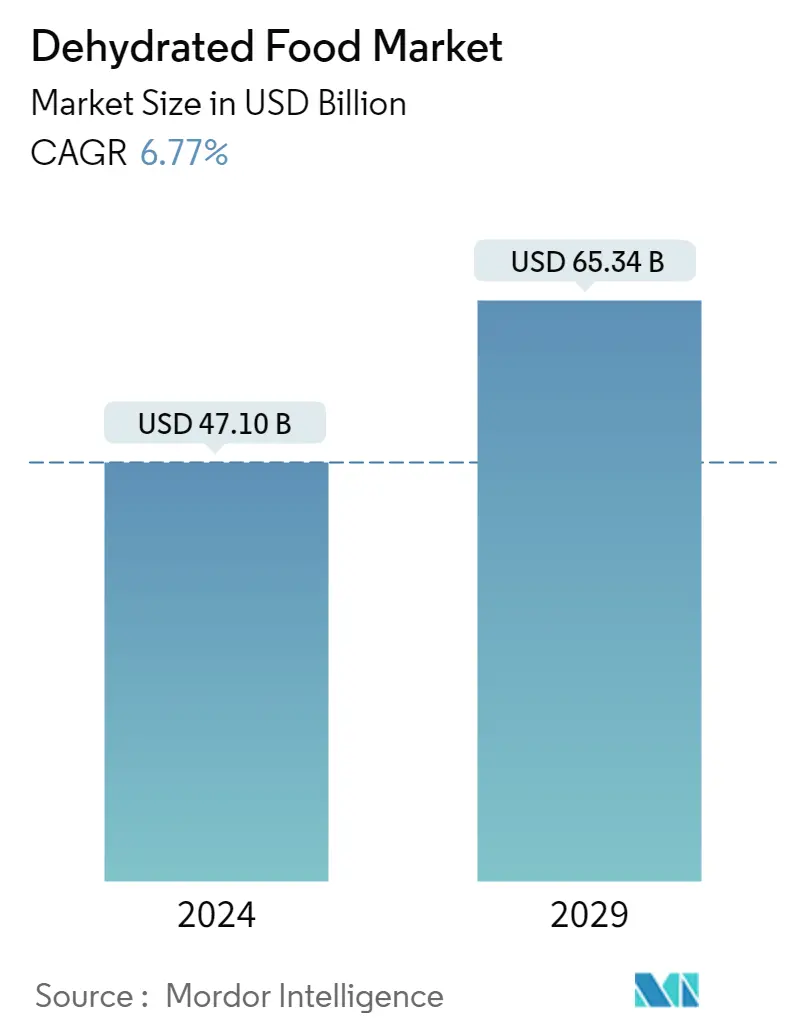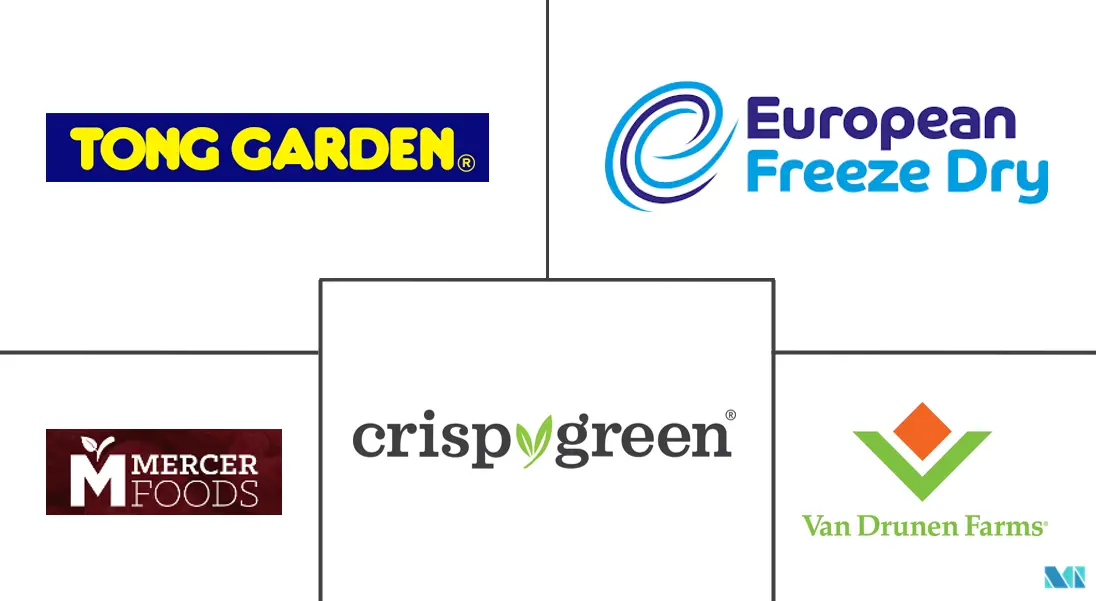Market Size of Dehydrated Food Industry

| Study Period | 2018 - 2029 |
| Market Size (2024) | USD 47.10 Billion |
| Market Size (2029) | USD 65.34 Billion |
| CAGR (2024 - 2029) | 6.77 % |
| Fastest Growing Market | Asia Pacific |
| Largest Market | North America |
Major Players
*Disclaimer: Major Players sorted in no particular order |
Need a report that reflects how COVID-19 has impacted this market and its growth?
Dehydrated Food Market Analysis
The Dehydrated Food Market size is estimated at USD 47.10 billion in 2024, and is expected to reach USD 65.34 billion by 2029, growing at a CAGR of 6.77% during the forecast period (2024-2029).
To maintain immunity, consumers are highly concerned about adding good protein content to their diet, which results in augmenting the sales of freeze-dried meat products, dairy products, and others that have more shelf-life together with similar nutrients than that fresh products. The applicability of the freeze-drying technology for heat-sensitive food products, an increase in freeze-dried pet food products, and the introduction of freeze-drying techniques into various food products for longer preservation and more convenient consumption are additional key market drivers.
Furthermore, vegan and plant-based freeze-dried food products are witnessing an excessive demand amid changing consumer demands. This is primarily due to the prolonged shelf life of freeze-dried products, which can be purchased in larger quantities to tackle hectic work schedules, over fresh food products that require frequent buying in lesser amounts. According to UN Comtrade, in 2021, imports of slices, cut, whole, powdered vegetables, and other forms into the United Kingdom (UK) were valued at approximately GBP 65 million. The overall market is driven considerably, primarily by North American and European consumers owing to their higher purchasing power, thus, adding up to the value of the market studied. The other major factor expected to push the market is growing e-commerce in developing economies; now, consumers in developing economies have easy access to dehydrated food products within the comfort of their homes. Also, startups are listing their innovative products on online retail channels, which helps drive the sales of dehydrated foods across the globe.
Dehydrated Food Industry Segmentation
Dehydrated food refers to the types of food that have been dried to remove most of their natural moisture to preserve the food, thus reducing the potential problems which can occur as fresh foods mold or become fermented.
The market studied is segmented by freezing technique, product type, distribution channel, and geography. By freezing procedure, the market is segmented into spray-dried, freeze-dried, vacuum-dried, drum-dried, and others. Based on product type, the market is segmented into dried processed food, dried fruit & vegetable, dried dairy, dried meat & seafood, and others. These products are distributed through hypermarkets/supermarkets, convenience stores, online retailing, and others. To give a broader market perspective, the market is studied for different countries under each region, namely North America, Europe, Asia-Pacific, South America, and the Rest of the Middle East & Africa. For each segment, the market sizing and forecasts have been done based on value (in USD million).
| By Type | |
| Spray-dried | |
| Freeze-dried | |
| Vacuum-dried | |
| Drum-dried | |
| Other Types |
| By Product Type | |
| Dried Processed Food | |
| Dried Fruit & Vegetable | |
| Dried Dairy | |
| Dried Meat & Seafood | |
| Other Product Type |
| By Distribution Channel | |
| Hypermarket/Supermarket | |
| Convenience Stores | |
| Online Retailing | |
| Other Distribution Channels |
| Geography | |||||||||
| |||||||||
| |||||||||
| |||||||||
| |||||||||
|
Dehydrated Food Market Size Summary
The Dehydrated Food Market is anticipated to witness significant growth during the forecast period, driven by increasing consumer preference for protein-rich diets and longer shelf-life food products. The market growth is further propelled by the application of freeze-drying technology in heat-sensitive food products, the rise in freeze-dried pet food products, and the introduction of freeze-drying techniques for longer preservation and convenient consumption. The demand for vegan and plant-based freeze-dried food products is also on the rise, mainly due to their extended shelf life, making them a preferred choice for consumers with busy schedules. The market is primarily driven by North American and European consumers, coupled with the growth of e-commerce in developing economies. The market trends indicate a growing demand for convenient processed food products, with dried foods like chips, nuts, popcorn, and others observing increased consumer demand. The extended shelf-life of dehydrated and freeze-dried snack products adds to their popularity among consumers. North America holds a significant market share, driven by increased consumption of meat and other animal-based products. Big-box stores like Target and Walmart are expanding their freeze-dried food products range, increasing customer awareness and visibility of these items. The market is highly competitive, with global and regional players focusing on production innovation and partnerships to meet demand and withstand competition. Expansion is a crucial strategy adopted by global players to gain competitiveness.
Explore MoreDehydrated Food Market Size - Table of Contents
-
1. MARKET DYNAMICS
-
1.1 Market Drivers
-
1.2 Market Restraints
-
1.3 Porter's Five Force Analysis
-
1.3.1 Threat of New Entrants
-
1.3.2 Bargaining Power of Buyers/Consumers
-
1.3.3 Bargaining Power of Suppliers
-
1.3.4 Threat of Substitute Products
-
1.3.5 Intensity of Competitive Rivalry
-
-
-
2. MARKET SEGMENTATION
-
2.1 By Type
-
2.1.1 Spray-dried
-
2.1.2 Freeze-dried
-
2.1.3 Vacuum-dried
-
2.1.4 Drum-dried
-
2.1.5 Other Types
-
-
2.2 By Product Type
-
2.2.1 Dried Processed Food
-
2.2.2 Dried Fruit & Vegetable
-
2.2.3 Dried Dairy
-
2.2.4 Dried Meat & Seafood
-
2.2.5 Other Product Type
-
-
2.3 By Distribution Channel
-
2.3.1 Hypermarket/Supermarket
-
2.3.2 Convenience Stores
-
2.3.3 Online Retailing
-
2.3.4 Other Distribution Channels
-
-
2.4 Geography
-
2.4.1 North America
-
2.4.1.1 United States
-
2.4.1.2 Canada
-
2.4.1.3 Mexico
-
2.4.1.4 Rest of North America
-
-
2.4.2 Europe
-
2.4.2.1 United Kingdom
-
2.4.2.2 Germany
-
2.4.2.3 France
-
2.4.2.4 Russia
-
2.4.2.5 Italy
-
2.4.2.6 Spain
-
2.4.2.7 Rest of Europe
-
-
2.4.3 Asia Pacific
-
2.4.3.1 India
-
2.4.3.2 China
-
2.4.3.3 Japan
-
2.4.3.4 Australia
-
2.4.3.5 Rest of Asia-Pacific
-
-
2.4.4 South America
-
2.4.4.1 Brazil
-
2.4.4.2 Argentina
-
2.4.4.3 Rest of South America
-
-
2.4.5 Middle East & Africa
-
2.4.5.1 South Africa
-
2.4.5.2 Saudi Arabia
-
2.4.5.3 Rest of Middle East & Africa
-
-
-
Dehydrated Food Market Size FAQs
How big is the Dehydrated Food Market?
The Dehydrated Food Market size is expected to reach USD 47.10 billion in 2024 and grow at a CAGR of 6.77% to reach USD 65.34 billion by 2029.
What is the current Dehydrated Food Market size?
In 2024, the Dehydrated Food Market size is expected to reach USD 47.10 billion.
